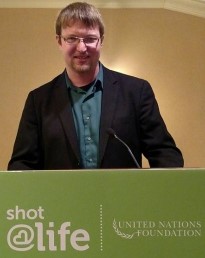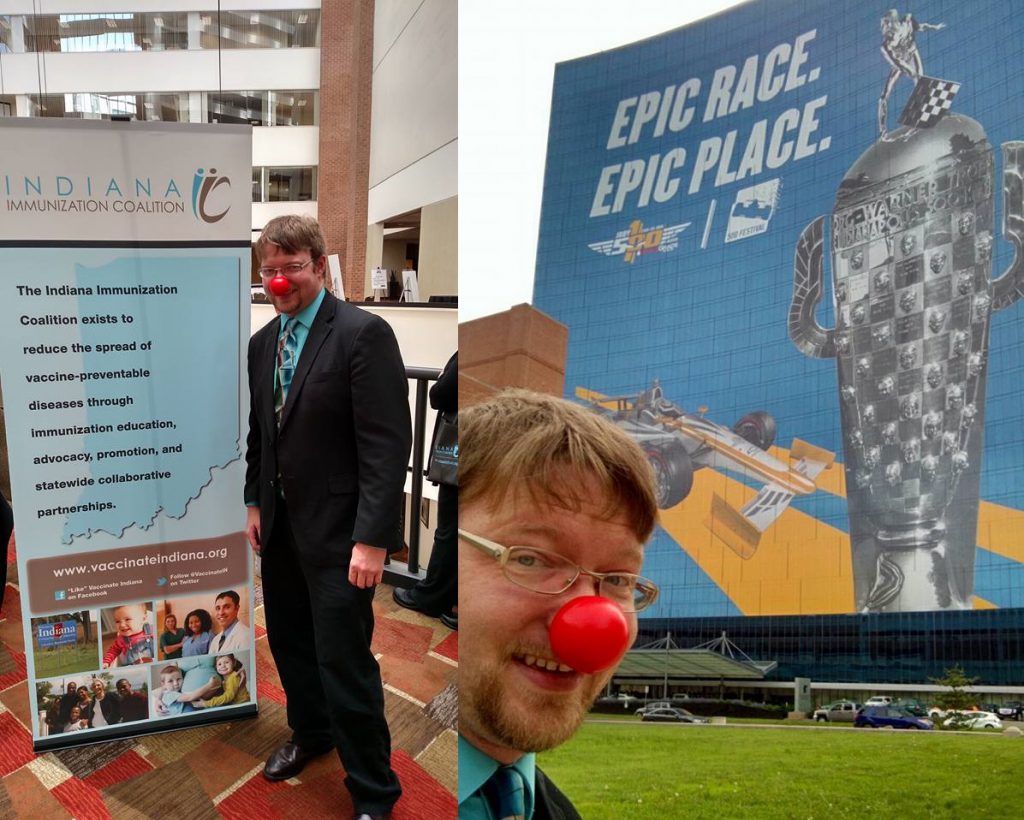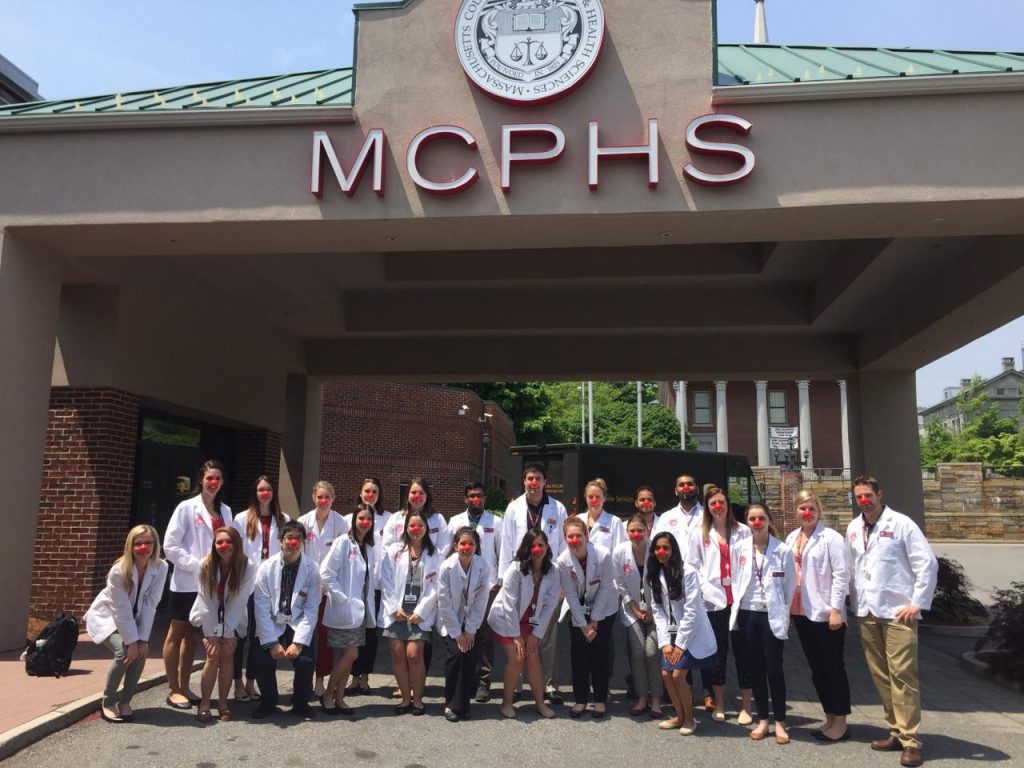
Matthew Pope is a Shot@Life Champion Leader for the state of Indiana, and has been an advocate for better health, education, and economic opportunity advocate with RESULTS, a stem-mentor through FIRST Robotics, and a registered disaster recovery specialist through the American Logistics Aid Network as well as an active member of his local Community Emergency Response Team through FEMA.
What types of activities did you do to support 2016 Red Nose Day?
Leading up to Red Nose Day this year, I promoted Red Nose Day, Shot@Life, and Gavi, the Vaccine Alliance through multiple social media accounts. I also submitted a couple of letters to the editor regarding Red Nose Day activities. In addition to my online activities, I tried to incorporate Red Nose Day into the kickoff event of Thursdays on the Roof in Indianapolis, multiple Indy 500 events, and the National Conference for Immunization Coalitions and Partnerships.
Can you talk about the National Conference for Immunization Coalitions and Partnerships that you attended?
The National Conference for Immunization Coalitions and Partnerships is a national gathering of coalition leaders, staff, and board members as well as public health workers, topic experts, and community advocates. While attending this important conference as a member of its program planning committee, I got to bridge together local and global activities pertaining to vaccination. Since the theme of this year’s conference was tied to the 100th running of the Indianapolis 500, I thought it was appropriate to also seek out opportunities around town that were tied to the Indy 500 to educate the general public about Red Nose Day and all the charities that are being supported through it.
Since many of the diseases that vaccines protect us against are often times just a plane ride away from reaching new populations, I think it is crucial that we bridge local and global vaccination endeavors together. We are all in this together. Where you live should not dictate whether you live. Everyone deserves a shot at life!

While his activities with Shot@Life focuses on global vaccination, he is also an advocate for immunizations on a domestic front as well.
This is just the second year RND has been in the U.S. Why do you think Americans should embrace this day?
It is important, fun, and extremely easy to embrace. By donning a red nose, sharing a laugh with those around you, and leveraging the gifts of people throughout our community, we are able to bring about massive changes across the globe. When I talk about ending poverty here and abroad, some people do not want to get involved because they feel the work is depressing to think about or that the problem could be never-ending. Red Nose Day shows people that it is not only important to help others in need, it can also be fun. The answers exist. Poverty is not permanent. We can put it in the history books where it belongs. It is just a matter of prioritizing the proper initiatives to get the job done.
Tell me about some of the things you have done to support Gavi?
I have written news articles about the work being done globally, shared lots of information via social media, and held in-person events that have provided educational opportunities to the general public. In addition to this, one of the most important things that I have done was help to get our elected officials to support Gavi’s most recent replenishment.
What can folks do to support organizations like Gavi or global childhood immunizations?
There are lots of ways that people can get involved in these types of endeavors. They can host fundraisers, write media pieces, and engage in conversations with their elected officials. It is important to note that these individuals do not have to do these things alone. We are all in this together. I would encourage people to become Shot@Life Champions, Immunization Ambassadors, and advocates with their state or area’s Immunization Coalition. Additionally, I would encourage individuals to become RESULTS volunteer activists, and if they are between the ages of 18 and 30, I would highly recommend they consider applying for the organization’s one year long REAL Change fellowship program for organizing and advocacy to fight poverty here and abroad. I would also implore individuals to follow these groups on social media and share their messages throughout their social networks.
Among our large body of student Champions, Javin Brita, a member of the Class of 2017 at MCPHS University’s Physician Assistant Program, contributed to Red Nose Day 2016.
How did you contribute to Red Nose Day?
I was first introduced to the idea by Dr. Fredenburg, one of our professors and a Champion Leader with Shot@Life, who suggested combining it with a fundraising opportunity for Shot@Life. Of course, I thought this was a great idea and immediately began polling the class to see who’d want to be involved. We ended up with 39 students and 2 professors, as well as another 2 students simply donating money to Shot@Life. I purchased 41 red nose in advance and that $41 was donated to Red Nose Day, but all donations I collected from the class and faculty (plus extra donations) went directly to Shot@Life! Overall, we raised $60 for Shot@Life! In the end, it was a win-win for Red Nose Day and Shot@Life. Most importantly we knew we would be making an impact on children’s lives through the various foundations supported by Red Nose Day as well as those supported by Shot@Life and hopefully, though indirectly, bring a smile to some faces.
What types of social media activities did you do to support RND?
I informed people that they can post and tweet #RNDforkids for the Gates foundation to donate $10 for every tweet. We also announced it on our Facebook page as well.
This is just the second year RND has been in the U.S. Why do you think Americans should embrace this day?
I think it’s an opportunity for Americans to give back to those in need, even to those outside of the country. Living in the U.S, we live very privileged lives and take many things for granted that many others don’t. I recently learned in epidemiology that cardiovascular disease is the most prevalent cause of disease in the United States. There is staging with epidemiology that varies by era, and one of the first stages was just infectious diseases. The U.S of course, is in later stages, but there are tons of countries that are still in that first stage that fit the category of infectious disease causing severe mortality. So I think it’s important for Americans to recognize this reality and that children around the world are impoverished and do not have the utilities and resources that we do.
What can folks do to support organizations like Gavi or global childhood immunizations?
I think the first step is consistent advocacy. Personally, I encourage my friends to check out the Shot@Life website, sign up to become a Champion. I try to support advocacy so that people can not only become aware, but also draw more people that will take action to help. Right now we are working on different things to come up with for Shot@Life such as fundraising events.
What does this mean to you?
What I did is a reflection of the program I am involved in, and also the actual genuine care that we have for childhood immunization. I looked at it as a duty as a healthcare provider. It wouldn’t make sense for us to not support this cause, and we genuinely care for this cause.

